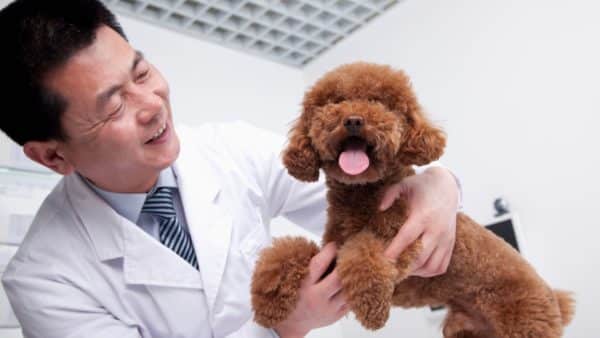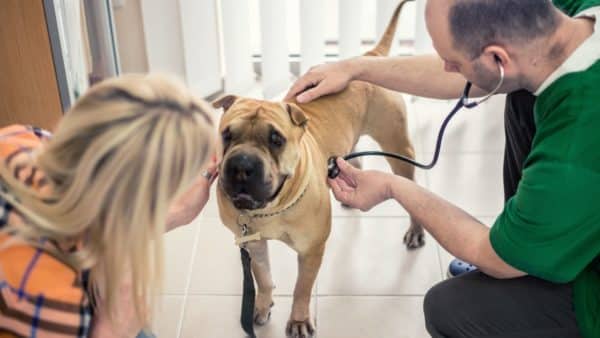

Dogs are susceptible to many types of cancer that also affect people. Cancer develops when there is an abnormal multiplication of cells that cannot be controlled in the body. Cells in any of the body’s tissues can be affected by cancer.
Cancer is one of the top causes of death in dogs 10 years of age and older. According to Dr. Dave Ruslander, a veterinary oncologist and past president of the Veterinary Cancer Society, “50% of dogs over the age of 10 develop cancer at some point”.
Early detection, diagnosis, and appropriate treatment are very important to improve the prognosis. Without this, cancer can spread to other tissues and organs in the body via the circulatory and lymphatic systems.
The high cancer rates in dogs can be quite alarming for pet owners. Experts attribute these figures to pets living longer and better lives because of advancements in veterinary medicine as well as pet care and nutrition. As dogs grow older, they become more prone to developing cancer.
In some types of cancer, genetics seem to play an important role in their development. Thus, some breeds appear to be more prone to cancer compared to others.

The classical signs of cancer in dogs are very similar to those in humans. The symptoms tend to differ greatly based on cancer’s type and location. Pet owners should be alert for any of the following signs:
Some dogs, however, exhibit little or no signs in the early phase of cancer. So any signs of illness or a change in your pet’s behavior should be brought to the attention of your veterinarian sooner rather than later.
Regular health (including dental) and wellness checks by your veterinarian are also important opportunities for early detection of any sign of cancer. These visits are just one of the ways that you can keep an eye on your dog’s health and behavior.
Elevate your dog’s well-being with our carefully selected range of top supplements designed to fortify and enhance their immune system. Our curated collection includes immune-boosting ingredients like vitamins C and E, antioxidants, and probiotics, all aimed at supporting a robust defense against illnesses.

Cancer can affect any part of the body– blood, bone, and other body tissues and organs. Having an accurate diagnosis is extremely important in order to provide the most appropriate treatment and an excellent prognosis. The most common cancers that have been diagnosed in dogs include the following:
According to the American Animal Hospital Association (AAHA), lymphoma accounts for 20% of all cancer cases in dogs.
Cases of lymphoma have been observed in various breeds and ages of dogs. The most commonly affected breed, however, is the golden retriever.
The most prominent symptom associated with lymphoma is the swelling of the lymph nodes under the dog’s jaw, in front of the shoulders, and/or behind the knees. Sometimes the chest or abdomen lymph nodes may also be affected.
The swelling of the lymph nodes in the chest will make it hard for the dog to breathe. On the other hand, vomiting and diarrhea may occur when the lymph nodes of the stomach are attacked.
Depending on the type, lymphoma is generally considered treatable. Favorable results are achieved with multi-drug chemotherapy. Dogs generally respond well to treatment.
This type of cancer typically affects the skin. Mast cell tumors can range from being benign to extremely aggressive types. They often metastasize (spread) to other parts of the body. Diagnosis of mast cell tumors is done using a fine-needle aspirate.
Cases of mast cell tumors are most often seen in boxers and bulldogs but have also been diagnosed in other canine breeds.
Affected dogs suffer from vomiting, diarrhea, and appetite loss. As you can see the symptoms are non-specific and could indicate a variety of other health issues.
A surgical incision of the entire mast cell tumor is generally indicated. For the more severe tumor grades, chemotherapy and radiation therapy are usually necessary.
According to the AAHA, osteosarcoma is the most common type of cancer that affects the bones of dogs. Although any bone of the body can be attacked by cancer, it’s the long bones of the limbs are commonly affected. Osteosarcoma progresses rapidly and can quickly metastasize to the dog’s lungs, lymph nodes, and other bones.
In the early part of osteosarcoma, the most distinct symptoms that pet owners usually notice in their dogs are mobility problems. There is pain swelling, and/or pain in the affected limb or any part of the body where the bone is attacked.
Amputation is often the most recommended treatment to prevent its rapid spread to other parts of the body. The dog will also undergo chemotherapy to address any metastases. Unfortunately, even with amputation and aggressive chemotherapy, fewer than 10% of dogs live longer than 3 years.
Osteosarcoma can affect dogs of any age or breed but cases are most often seen in mastiffs, Great Danes, and Irish wolfhounds.
Melanoma is a type of oral cancer that is very common in dogs. These tumors are comprised of cells with dark pigments and can also be found anywhere else in the body. When malignant melanoma develops in the dog’s mouth, it has often spread throughout the body before symptoms are noticed.
Melanoma can affect any canine breed but is frequently diagnosed in chow chows, Scottish terriers, Doberman pinschers, schnauzers (standard and miniature), and other dog breeds with characteristic dark tongues and gums.
Unfortunately, melanoma is incurable. It is difficult to completely remove the tumor with surgery. Aggressive chemotherapy and radiation treatment are ineffective against any metastasis. There are ongoing studies, however, which are showing promising results in melanoma treatment. These studies use immune-based therapies.
Mammary gland carcinomas commonly affect intact or unspayed female dogs. In the beginning, mammary gland carcinomas develop as small nodules around the dog’s nipple. More often than not, the tumors are often overlooked until such time that they become large and painful.
The tumors may also ulcerate and the open wounds are prone to secondary infections. About 50% of mammary gland carcinomas in dogs are malignant, and 50% of these malignant cases are fatal.
The best way to significantly reduce a female dog’s risk of developing carcinomas of the mammary gland is to have her spayed before she reaches puberty, that is, before her first heat cycle.
Mammary gland carcinomas can affect any breed of dog, particularly older, intact females.
Surgical removal of the tumors can be an effective treatment if cancer has not spread to other parts of the body.
Hemangiosarcoma affects the cells lining the blood vessels. The most common organ that is attacked by the cancer cells is the spleen, but cases involving the heart, liver, and skin have also been diagnosed.
When the tumor occurs in the spleen, affected dogs seldom exhibit any signs of illness until such time that the tumor ruptures. When this happens, extreme blood loss can eventually cause the dog to go into shock and experience labored breathing, weakness, and pale gums.
Emergency surgery is required to stop the blood loss. The dog will then undergo chemotherapy. Unfortunately, most cases of hemangiosarcoma are often diagnosed when they have already progressed or may have ruptured, and treatment is often too late.
The most commonly affected canine breeds are German shepherds, golden retrievers, Skye terriers, and Portuguese water dogs. However, cases of hemangiosarcoma have also been diagnosed in other breeds of dogs.

As with any disease, early detection is extremely important for best results. Here’s a recap of the early warning signs or ‘red flags’ that indicate cancer in dogs that pet owners should keep an eye out for.
Taken note, however, that these symptoms are not specific to cancer; they may also be present in other types of health issues.
If you notice any of these symptoms, you should have your pet checked by a veterinarian immediately.
If cancer is suspected, the veterinarian may recommend several diagnostic tests to confirm the initial diagnosis. These may include blood screening, x-rays, ultrasound, or MRI scanning.
Biopsy, which involves taking a sample of the tumor for microscopic examination, may help identify the type of tumor and whether it’s malignant or not.
The ultimate goal of cancer treatment is to completely and permanently remove cancer. Sadly, this is not often the case for many types of cancer in dogs.
There are three common treatment options for cancer in dogs–surgery, chemotherapy, and radiation therapy. Each of these treatment options can be given alone or in combination with other regimens.
The treatment options that will be recommended by your veterinarian will depend on several factors, such as the type of cancer, how rapidly it grows and spread to other parts of the body, and the location of the tumor.
In dog patients whose cancer is incurable, the veterinarian will provide treatment to alleviate pain and discomfort and improve the patient’s quality of life.
Most of us train our dogs when they are puppies to jump up on furniture. We think it’s harmless (and easier than always lifting them), but for dogs, couches and beds are very high compared to the size of their bodies.
Every time they jump it compresses their back and applies enormous force to their joints.
It’s no wonder that an incredible 80% of dogs experience arthritis or joint pain by only 7 years old.
Luckily, there is a vet-recommended solution.
It’s the PawRamp by Alpha Paw. An adjustable ramp that allows dogs to safely get on and off couches and beds. PawRamp makes joining you in bed or on the couch effortless and fun.
As a bonus, you can use code SAVE35 to get $35 off the PawRamp today.

The medical, nutritional, or behavioral advice we provide is intended for informational and educational purposes only. Our editorial content is not a substitute for formal or personalized medical advice from a veterinary professional. Only board-certified veterinary specialists who have examined your pet should diagnose medical conditions, provide personalized treatment, or prescribe appropriate medication. For questions regarding your pet’s health, or if your pet is exhibiting signs of illness, injury, or distress, contact your veterinarian immediately. Never disregard professional medical advice or delay in seeking it because of something you have read on our site.